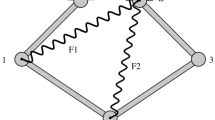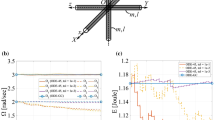Abstract
The optimization of the dynamic response of multibody dynamic systems is a complex and open problem. It relies on using the equations of motion of the system, which amplifies the level of complexity of the problem substantially, compared to other types of optimization. In the context of this kind of optimization, the sensitivity analysis of the dynamic response of the system is a key element. Two main techniques are currently available for the sensitivity analysis of the response of a dynamical system: the direct differentiation method and the adjoint variable method. In this work, different formulations of the equations of motion with dependent coordinates are employed and their sensitivity equations obtained. Direct and adjoint sensitivities are convenient for different types of problems but both methods require accurate derivatives of the equations of motion considered. Both approaches are employed in this work; the direct and adjoint sensitivity equations are obtained for index-3 differential-algebraic equations (DAE), index-1 DAE, and penalty formulations. The adjoint sensitivity for the penalty formulations introduced here is completely novel.
Access this chapter
Tax calculation will be finalised at checkout
Purchases are for personal use only
Similar content being viewed by others
References
Ascher UM, Petzold LR (1998) Computer methods for ordinary differential equations and differential-algebraic equations. Soc Ind Appl Math
Brenan KE, Campbell SL, Petzold LR (1989) Numerical solution of initial-value problems in differential-algebraic equations. North-Holland, New York
Bottasso CL, Dopico D, Trainelli L (2008) On the optimal scaling of index three daes in multibody dynamics. Multibody Sys Dyn 19(1–2):3–20 cited By (since 1996) 7
Bauchau OA, Epple A, Bottasso CL (2009) Scaling of constraints and augmented Lagrangian formulations in multibody dynamics simulations. J Comput Nonlinear Dyn 4, 021007. doi:10.1115/1.3079826
Bayo E, García de Jalon J, Serna MA (1988) A modified lagrangian formulation for the dynamic analysis of constrained mechanical systems. Comput Methods Appl Mech Eng 71(2):183–195
Bestle D, Seybold J (1992) Sensitivity analysis of constrained multibody systems. Arch Appl Mech 62:181–190
Cuadrado J, Cardenal J, Morer P, Bayo E (2000) Intelligent simulation of multibody dynamics: space-state and descriptor methods in sequential and parallel computing environments. Multibody Sys Dyn 4(1):55–73
Cuadrado J, Gutierrez R, Naya MA, Morer P (2001) A comparison in terms of accuracy and efficiency between a mbs dynamic formulation with stress analysis and a non-linear fea code. Int J Numer Methods Eng 51(9):1033–1052
Ding Jie-Yu, Pan Zhen-Kuan, Chen Li-Qun (2007) Second order adjoint sensitivity analysis of multibody systems described by differential-algebraic equations. Multibody Sys Dyn 18:599–617
Dopico D, Zhu Y, Sandu A, Sandu C (2014) Direct and adjoint sensitivity analysis of ODE multibody formulations. J Comput Nonlinear Dyn. doi:10.1115/1.4026492
Eich-Soellner E, Führer C (1998) Numerical Methods in Multibody Dynamics. B.G.Teubner, Stuttgart
Garcia de Jalon J, Bayo E (1994) Kinematic and dynamic simulation of multibody systems: the real-time challenge. Springer, New York
Haug EJ, Arora JS (1979) Applied optimal design: mechanical and structura systems. Wiley, New York
Haug E (1987) Design sensitivity analysis of dynamic systems. Number 27 in NATO ASI series. Series F, computer and systems sciences. In: Computer aided optimal design: structural and mechanical systems, Springer, Berlin
Haug EJ (1989) Computer aided kinematics and dynamics of mechanical systems: basic methods. Allyn and Bacon. Prentice Hall College Div, Boston
Hairer E, Lubich C, Wanner G (2006) Geometric numerical integration. Structure-preserving algorithms for ordinary differential equations, vol 31, 2nd edn. Springer, Berlin (Springer Series in Computational Mathematics)
Pagalday JM, Avello A (1997) Optimization of multibody dynamics using object oriented programming and a mixed numerical-symbolic penalty formulation. Mech Mach Theory 32(2):161–174
Pagalday JM (1994) Optimizacion del comportamiento dinamico de mecanismos. PhD thesis, Escuela Superior de Ingenieros Industriales de S. Sebastian
Petzold L, Lötstedt P (1986) Numerical solution of nonlinear differential equations with algebraic constraints ii: practical implications. SIAM J Sci Stat Comput 7(3):720–733
Sonneville Valentin, Brüls Olivier (2014) Sensitivity analysis for multibody systems formulated on a lie group. Multibody Sys Dyn 31(1):47–67
Schaffer A (2005) Stability of the adjoint differential-algebraic equation of the index-3 multibody system equation of motion. SIAM J Sci Comput 26(4):1432–1448
Schaffer A (2006) Stabilized index-1 differential-algebraic formulations for sensitivity analysis of multi-body dynamics. Proc Inst Mech Eng Part K J Multibody Dyn 220(3):141–156
Zhang H, Sandu A (2012) Fatode: a library for forward, adjoint, and tangent linear integration of odes. http://people.cs.vt.edu/~asandu/Software/FATODE/index.html
Acknowledgments
This work was supported in part by award NSF CMMI-1130667 and by the Computational Science Laboratory at Virginia Tech.
Author information
Authors and Affiliations
Corresponding author
Editor information
Editors and Affiliations
Appendix: Nomenclature and Differentiation Rules
Appendix: Nomenclature and Differentiation Rules
-
\(\left( \cdots \right) _0\): means evaluation at the initial time \(\left( \cdots \right) \left( t_0\right) \).
-
\(\left( \cdots \right) _F\): means evaluation at the final time \(\left( \cdots \right) \left( t_F\right) \).
-
\(\mathbf{q} \in {\mathbb {R}}^{n}\): vector of coordinates of the system.
-
\({\varvec{\rho }} \in {\mathbb {R}}^{p}\): vector of parameters.
-
\(\delta \left( \right) \): means variation.
-
\(\left( \right) _\mathbf{q} = \displaystyle \dfrac{\partial \left( \right) }{\partial \mathbf{q}}; \; \left( \right) _{\varvec{\rho }} = \displaystyle \dfrac{\partial \left( \right) }{\partial {\varvec{\rho }}} \)
-
\(\dot{\left( \right) } = \displaystyle \dfrac{\mathrm{d}\left( \right) }{\mathrm{d}t}; \; \ddot{\left( \right) } = \displaystyle \dfrac{\mathrm{d}^2\left( \right) }{\mathrm{d}t^2} \; \left( \right) _{t} = \displaystyle \dfrac{\partial \left( \right) }{\partial t}\)
-
\(\mathbf{M}\left( \mathbf{q},{\varvec{\rho }}\right) \in {\mathbb {R}}^{n \times n}\): generalized mass matrix of the system.
-
\(\mathbf{Q}\left( t,\mathbf{q},\dot{\mathbf{q}},{\varvec{\rho }} \right) \in {\mathbb {R}}^{n}\): vector of generalized forces of the system.
-
\({\varvec{\Phi }}\left( t,\mathbf{q},{\varvec{\rho }} \right) \in {\mathbb {R}}^{m}\): vector of constraints that relate the dependent coordinates.
-
\(\mathbf{A}_\mathbf{x} = \left[ \begin{array}{c c c c c} \displaystyle \frac{\partial \mathbf{A}}{\partial x_1}&\ldots&\displaystyle \frac{\partial \mathbf{A}}{\partial x_i}&\ldots&\displaystyle \frac{\partial \mathbf{A}}{\partial x_{s}} \end{array}\right] \in {\mathbb {R}}^{q{\times }r{\times }s} \). Third order tensor of derivatives of matrix \(\mathbf{A} \in {\mathbb {R}}^{q{\times }r}\) w.r.t. vector \(\mathbf{x} \in {\mathbb {R}}^{s}\).
-
\(\mathbf{A}_\mathbf{x}^\mathrm{T} =\left[ \begin{array}{c c c c c} \displaystyle \frac{\partial \mathbf{A}^\mathrm{T}}{\partial x_1}&\ldots&\displaystyle \frac{\partial \mathbf{A}^\mathrm{T}}{\partial x_i}&\ldots&\displaystyle \frac{\partial \mathbf{A}^\mathrm{T}}{\partial x_{s}} \end{array}\right] \in {\mathbb {R}}^{r{\times }q{\times }s} \).
-
\(\mathbf{A}_\mathbf{x}\mathbf{b} = \mathbf{A}_\mathbf{x}\otimes \mathbf{b} = \left[ \begin{array}{c c c c c} \displaystyle \frac{\partial \mathbf{A}}{\partial x_1} \mathbf{b}&\ldots&\displaystyle \frac{\partial \mathbf{A}}{\partial x_i} \mathbf{b}&\ldots&\displaystyle \frac{\partial \mathbf{A}}{\partial x_{s}} \mathbf{b} \end{array}\right] \in {\mathbb {R}}^{q{\times }s}\), where \(\mathbf{b} \in {\mathbb {R}}^{r}\) is a vector.
-
\(\mathbf{A}_\mathbf{x}\mathbf{B} = \mathbf{A}_\mathbf{x}\otimes \mathbf{B} = \left[ \begin{array}{c c c c c} \displaystyle \frac{\partial \mathbf{A}}{\partial x_1} \mathbf{B}&\ldots&\displaystyle \frac{\partial \mathbf{A}}{\partial x_i} \mathbf{B}&\ldots&\displaystyle \frac{\partial \mathbf{A}}{\partial x_{s}} \mathbf{B} \end{array}\right] \in {\mathbb {R}}^{q{\times }t{\times }s}\), where \(\mathbf{B} \in {\mathbb {R}}^{r{\times }t}\) is a matrix.
-
\(\mathbf{C} \mathbf{A}_\mathbf{x}\mathbf{B} = \mathbf{C} \otimes \mathbf{A}_\mathbf{x}\mathbf{B} = \left[ \begin{array}{c c c c c} \mathbf{C} \displaystyle \frac{\partial \mathbf{A}}{\partial x_1} \mathbf{B}&\ldots&\mathbf{C} \displaystyle \frac{\partial \mathbf{A}}{\partial x_i} \mathbf{B}&\ldots&\mathbf{C} \displaystyle \frac{\partial \mathbf{A}}{\partial x_{s}} \mathbf{B} \end{array}\right] \in {\mathbb {R}}^{r{\times }t{\times }s}\), where \(\mathbf{C} \in {\mathbb {R}}^{r{\times }q}\) is a matrix.
Rights and permissions
Copyright information
© 2014 Springer International Publishing Switzerland
About this chapter
Cite this chapter
Dopico, D., Sandu, A., Sandu, C., Zhu, Y. (2014). Sensitivity Analysis of Multibody Dynamic Systems Modeled by ODEs and DAEs. In: Terze, Z. (eds) Multibody Dynamics. Computational Methods in Applied Sciences, vol 35. Springer, Cham. https://doi.org/10.1007/978-3-319-07260-9_1
Download citation
DOI: https://doi.org/10.1007/978-3-319-07260-9_1
Published:
Publisher Name: Springer, Cham
Print ISBN: 978-3-319-07259-3
Online ISBN: 978-3-319-07260-9
eBook Packages: EngineeringEngineering (R0)




